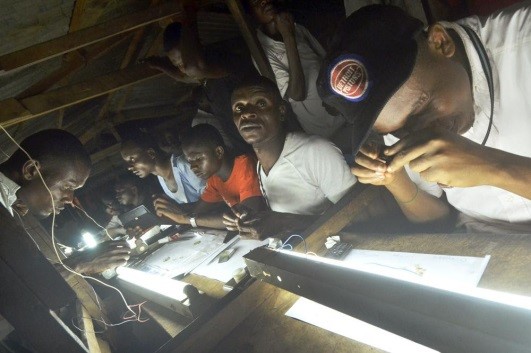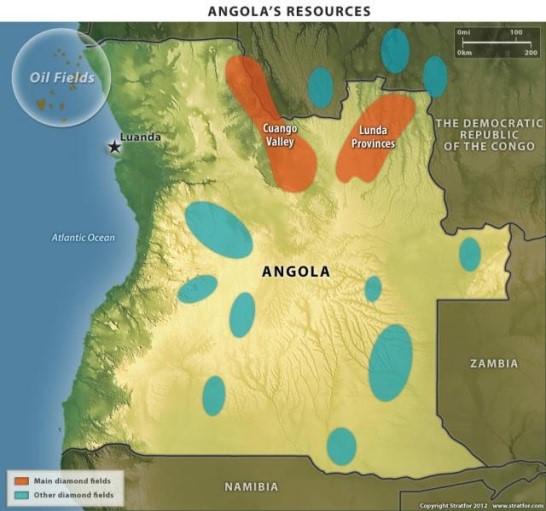 The history of the development of diamonds in Angola and the Democratic Republic of the Congo is deeply entrenched in violence. Officials from the two countries have been meeting in the northeastern Angolan town of Dundo to discuss the conflict-free development of diamonds found in their countries.
The history of the development of diamonds in Angola and the Democratic Republic of the Congo is deeply entrenched in violence. Officials from the two countries have been meeting in the northeastern Angolan town of Dundo to discuss the conflict-free development of diamonds found in their countries.
However, Luanda and Kinshasa are less concerned about the humanitarian welfare of those mining their country’s diamonds than about making sure the resource is not used to restart either a proxy conflict against each other or a civil war within either country.
The Angolan government is promoting the development of diverse economic sectors in order to expand its economy beyond the narrow hydrocarbons sector Luanda has historically depended on. Hydrocarbons are by far the most significant component of the Angolan economy, responsible for approximately 96 percent of the country's export earnings. But essentially all of Angola's hydrocarbon resources are located offshore. Thus the hydrocarbons sector is akin to an enclave economy, with little contribution to the everyday lives of ordinary Angolans. The Angolan government's attempts to diversify the economy and access underdeveloped regions of the country are meant in part to address to the socio-economic interests of the underemployed majority and the commercial interests of the ruling elite.
Luanda's decision to turn to diamonds is deliberate. Diamonds are Angola's second-largest economic sector. Although diamond exports generate only 2 percent of the country's foreign exchange earnings, the strategic potential of diamonds is significant. Angolan diamonds account for an estimated 7 percent of the world's diamond production by volume and 8 percent by value. The Angolan diamond sector has been underdeveloped due to the country's civil war and, until recently, inadequate infrastructure that limited access to the resources.
The selection of Dundo as the meeting site was probably also deliberate. The town is located in Angola's Lunda Norte province, where alluvial diamond mining occurs. The Angolan government has been supporting infrastructure initiatives that enable greater development of the diamond resources found there. Angola's state diamond mining company, Endiama Mining, has relocated its headquarters to Dundo. The Angolan Ministry of Energy is planning to build a new thermal power plant in Dundo and refurbish an existing hydroelectric power plant in Lunda Norte to support rural mines such as those at Laurica, Calonda, Fucauma and Tchegi. Roads have been upgraded in Lunda Norte and connect the remote and otherwise undeveloped province to Angola's refurbished Benguela rail line that travels between the Congolese border at Luau and the Atlantic Ocean port at Benguela city. These developments in Lunda Norte -- and in Angola in general -- contributed to the De Beers diamond company's recent statement that it intends to acquire exploration licenses in Angola and begin work by the end of the year.
 While diamond mining in Angola and the Democratic Republic of the Congo is largely conflict-free, this is a recent development. Previously, these governments and Angolan rebels used the resource to finance wars in Angola. The Angolan rebel group-turned-opposition party, the National Union for the Total Independence of Angola, financed its 1975-2002 rebellion largely through the exploitation of alluvial diamonds in Lunda Norte province. The rebel group and African governments supportive of the Angolan rebels smuggled hundreds of millions of dollars' worth of diamonds out of Lunda Norte to willing buyers elsewhere in Africa, Europe and the Middle East. The Democratic Republic of the Congo (then known as Zaire) under President Mobutu Sese Seko was the National Union for the Total Independence of Angola's leading backer in Africa (others included Zambia under Frederick Chiluba, the Republic of the Congo under Pascal Lissouba, South Africa, Ivory Coast, Burkina Faso and Togo). Mobutu and others enabled the rebels to use their territory and government facilities to smuggle diamonds in exchange for fuel, weapons and other supplies for fighting.
While diamond mining in Angola and the Democratic Republic of the Congo is largely conflict-free, this is a recent development. Previously, these governments and Angolan rebels used the resource to finance wars in Angola. The Angolan rebel group-turned-opposition party, the National Union for the Total Independence of Angola, financed its 1975-2002 rebellion largely through the exploitation of alluvial diamonds in Lunda Norte province. The rebel group and African governments supportive of the Angolan rebels smuggled hundreds of millions of dollars' worth of diamonds out of Lunda Norte to willing buyers elsewhere in Africa, Europe and the Middle East. The Democratic Republic of the Congo (then known as Zaire) under President Mobutu Sese Seko was the National Union for the Total Independence of Angola's leading backer in Africa (others included Zambia under Frederick Chiluba, the Republic of the Congo under Pascal Lissouba, South Africa, Ivory Coast, Burkina Faso and Togo). Mobutu and others enabled the rebels to use their territory and government facilities to smuggle diamonds in exchange for fuel, weapons and other supplies for fighting.
Fighting between the Angolan government and the rebels for control over Lunda Norte in the late 1990s was a life-or-death struggle to determine whether the rebels could sustain the insurgency (the government had its own secure funding base in the hydrocarbons sector, which was never subjected to a meaningful rebel attack). The Angolan government finally secured Lunda Norte in the late 1990s and took aim at regional governments supporting the rebels. Zaire's Mobutu and the Republic of the Congo's Lissouba were overthrown in 1997 by domestic insurgencies with Angolan backing. Successive governments got the message to support the National Union for the Total Independence of Angola on pain of death. The rebel group lost its access to diamonds and foreign backers, and after its founder Jonas Savimbi was killed on the battlefield in 2002, the National Union for the Total Independence of Angola never recovered its war fighting capability. It took the Angolan government much of the rest of the 2000s to consolidate its political control across the whole of the country.
Now that its national security is unchallenged and revenue is no longer needed to prosecute a civil war, Angola has devoted its attention to economic development beyond the offshore hydrocarbons sector. The Angolan government, still mindful that the civil war ended not too long ago, wants to ensure the significance of diamond mining remains under its full control.
Courtesy : Stratfor (www.stratfor.com)